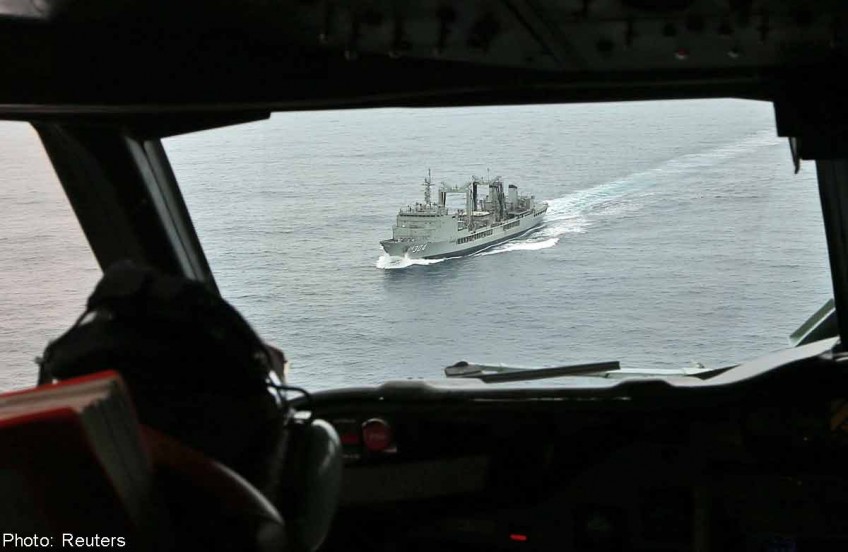Malaysia plane search intensifies on new debris data

PERTH, Australia - Ships and planes from several nations swarmed over the southern Indian Ocean on Monday as mounting evidence of floating debris energised the search for Malaysia's missing passenger jet.
But the challenge of recovering the elusive and still-unidentified flotsam took on added urgency as a tropical cyclone loomed to the north, threatening to worsen already rough conditions that have thwarted spotters.
China said Monday that one of its aircraft scouring the area had seen "suspicious" debris, adding to an Australian aircraft's visual sighting Saturday of a wooden pallet alongside strapping and other debris.
France and China both released satellite information at the weekend that also indicated floating objects far off Australia's west coast - buoying hopes of a breakthrough in the more than two-week-old puzzle.
A growing international fleet of military and civilian aircraft has converged on the region, supported by Australian and British naval vessels tasked with retrieving any objects from the forbidding waters.
Malaysia Airlines Flight MH370 vanished without warning on March 8 after suddenly veering off course over the South China Sea en route from Kuala Lumpur to Beijing with 227 passengers and 12 crew.
'Clutching' at information
China's Xinhua news agency said searchers spotted "two relatively big floating objects with many white smaller ones scattered within a radius of several kilometres", citing a reporter aboard a Chinese aircraft.
The Australian Maritime Safety Authority (AMSA) said attempts would be made to reach the objects.
Australia's Deputy Prime Minister Warren Truss cautioned against false hopes in a search that has hit a number of dead ends.
"We're just, I guess, clutching at whatever little piece of information comes along to try and find a place where we might be able to concentrate the efforts," he told national radio.
The US Navy added to the sense of an approaching denouement, ordering a specialised black box locator sent to the region around 2,500 kilometres (1,500 miles) southwest of Perth.
Recovery of the black box will be crucial to determining what happened to the Boeing 777.
Malaysia has said the plane was deliberately diverted by someone on board but the absence of firm evidence has fuelled a host of theories, and tormented family members seeking information on their loved ones.
The listening device is able to locate black boxes as deep as 20,000 feet (6,100 metres), the US Seventh Fleet said in a statement. The area being searched ranges from 3,000-4,000 metres deep.
Moving the device into place was aimed at ensuring "we will be able to respond as quickly as possible since the battery life of the black box's pinger is limited", the statement said.
The 30-day signal from the black box is due to fail in less than two weeks. The focus of the search had initially centred on waters around Southeast Asia but swung deep into the Indian Ocean last week after initial satellite images depicted large floating objects there.
AMSA said 10 aircraft were now involved in a search effort beefed up by the inclusion of two Chinese military aircraft which took to the air Monday, joining Australian, US, and Japanese planes.
China has also dispatched seven ships, adding to British and Australian naval vessels involved.
Tropical cyclone looms
The search has been hampered so far by rain, wind, storm-tossed seas, low clouds and fog.
AMSA said Tropical Cyclone Gillian, hundreds of kilometres to the north, was expected to weaken and would not affect the search, but Truss said "certainly it could stir up less favourable weather".
Satellite and military radar data suggest MH370 backtracked over the Malaysian peninsula and then flew on - possibly for hours - to parts unknown.
Leading theories include a hijacking, pilot sabotage, or a sudden mid-air crisis that incapacitated flight crew and left the plane to fly on auto-pilot until it ran out of fuel.
If debris is confirmed and no survivors found, a huge challenge remains in retrieving the cockpit data in the black box, said Charitha Pattiaratchi, an oceanographer at the University of Western Australia.
MH370's black box will be much more difficult to find than that of the Air France jet which went down in the Atlantic in 2009, he said, adding that wave heights could climb to seven metres in coming days.
"We have to remember that Air France 447 took two years to find and this is a more challenging region where the environment is much, much harsher. There are bigger waves and it's windier," he said.
Two thirds of the passengers were Chinese. Their grief and frustration has repeatedly boiled over, including in weekend meetings in Beijing where police had to restrain angry relatives who accused Malaysian officials of withholding information.
"Very often I feel like I'm about to go insane. My emotions are all over the place. I asked the Malaysians to give the answers and they said they couldn't," one relative said Sunday.